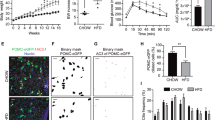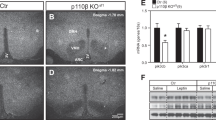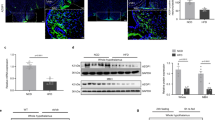Abstract
Energy balance is monitored by the hypothalamus. Malonyl-CoA, an intermediate in fatty acid synthesis, serves as an indicator of energy status in the hypothalamic neurons. The cellular malonyl-CoA level is determined by its rate of synthesis, catalyzed by acetyl-CoA carboxylase (ACC), and rate of removal, by fatty acid synthase (FAS). Malonyl-CoA functions in the hypothalamic neurons that express orexigenic and anorexigenic neuropeptides. Inhibitors of FAS, administered systemically or intracerebroventricularly to mice, increase hypothalamic malony-CoA and suppress food intake. Recent evidence suggests that the changes of hypothalamic malonyl-CoA during feeding and fasting cycles are caused by changes in the phosphorylation state and activity of ACC mediated via 5′-AMP-activated protein kinase (AMPK). Stereotactic delivery of a viral malonyl-CoA decarboxylase (MCD) vector into the ventral hypothalamus lowers malonyl-CoA and increases food intake. Fasting decreases hypothalamic malonyl-CoA and refeeding increases hypothalamic malonyl-CoA, to alter feeding behavior in the predicted manner. Malonyl-CoA level is under the control of AMP kinase which phosphorylates/inactivates ACC. Malonyl-CoA is an inhibitor of carnitine palmitoyl-CoA transferase-1 (CPT1), an outer mitochondrial membrane enzyme that regulates entry into, and oxidation of fatty acids, by mitochondria. CPT1c, a recently discovered, brain-specific enzyme expressed in the hypothalamus, has high sequence similarity to liver/muscle CPT1a/b and binds malonyl-CoA, but does not catalyze the prototypical reaction. This suggests that CPT1c has a unique function or activation mechanism. CPT1c knockout (KO) mice have lower food intake, weigh less and have less body fat, consistent with the role as an energy-sensing malonyl-CoA target. Paradoxically, CPT1c protects against the effects of a high-fat diet. CPT1cKO mice exhibit decreased rates of fatty acid oxidation, consistent with their increased susceptibility to diet-induced obesity. We suggest that CPT1c may be a downstream target of malonyl-CoA that regulates energy homeostasis.
This is a preview of subscription content, access via your institution
Access options
Subscribe to this journal
Receive 12 print issues and online access
$259.00 per year
only $21.58 per issue
Buy this article
- Purchase on Springer Link
- Instant access to full article PDF
Prices may be subject to local taxes which are calculated during checkout
Similar content being viewed by others
References
Loftus TM, Jaworsky DE, Frehywot GL, Townsend CA, Ronnett GV, Lane MD et al. Reduced food intake and weight in mice treated with fatty acid synthase inhibitors. Science 2000; 288: 2379–2381.
Hu Z, Cha SH, Chohnan S, Lane MD . Hypothalamic malonyl-CoA as a mediator of feeding behavior. Proc Natl Acad Sci USA 2003; 100: 12624–12629.
Gao S, Lane MD . Effect of the anorectic fatty acid synthase inhibitor C75 on neuronal activity in the hypothalamus and brainstem. Proc Natl Acad Sci USA 2003; 100: 5628–5633.
Shimokawa T, Kumar MV, Lane MD . Effect of a fatty acid synthase inhibitor on food intake and expression of hypothalamic neuropeptides. Proc Natl Acad Sci USA 2002; 99: 66–71.
Kim EK, Miller I, Landree LE, Borisy-Rudin FF, Brown P, Tihan T et al. Expression of FAS within hypothalamic neurons: a model for decreased food intake after C75 treatment. Am J Physiol Endocrinol Metab 2002; 283: E867–E879.
Kumar MV, Shimokawa T, Nagy TR, Lane MD . Differential effects of a centrally acting fatty acid synthase inhibitor in lean and obese mice. Proc Natl Acad Sci USA 2002; 99: 1921–1925.
Thupari JN, Landree LE, Ronnett GV, Kuhajda FP . C75 increases peripheral energy utilization and fatty acid oxidation in diet-induced obesity. Proc Natl Acad Sci USA 2002; 99: 9498–9502.
Cha SH, Hu Z, Chohnan S, Lane MD . Inhibition of hypothalamic fatty acid synthase triggers rapid activation of fatty acid oxidation in skeletal muscle. Proc Natl Acad Sci USA 2005; 102: 557–562.
Cha SH, Rodgers JT, Puigserver P, Chohnan S, Lane MD . Hypothalamic malonyl-CoA triggers mitochondrial biogenesis and oxidative gene expression in skeletal muscle: Role of PGC-1alpha. Proc Natl Acad Sci USA 2006; 103: 15410–15415.
Hardie DG . AMP-activated protein kinase: a master switch in glucose and lipid metabolism. Rev Endocr Metab Disord 2004; 5: 119–125.
Hardie DG . Regulation of fatty acid synthesis via phosphorylation of acetyl-CoA carboxylase. Prog Lipid Res 1989; 28: 117–146.
Kahn BB, Alquier T, Carling D, Hardie DG . AMP-activated protein kinase: ancient energy gauge provides clues to modern understanding of metabolism. Cell Metab 2005; 1: 15–25.
Kim EK, Miller I, Aja S, Landree LE, Pinn M, McFadden J et al. C75, a fatty acid synthase inhibitor, reduces food intake via hypothalamic AMP-activated protein kinase. J Biol Chem 2004; 279: 19970–19976.
Minokoshi Y, Alquier T, Furukawa N, Kim YB, Lee A, Xue B et al. AMP-kinase regulates food intake by responding to hormonal and nutrient signals in the hypothalamus. Nature 2004; 428: 569–574.
Andersson U, Filipsson K, Abbott CR, Woods A, Smith K, Bloom SR et al. AMP-activated protein kinase plays a role in the control of food intake. J Biol Chem 2004; 279: 12005–12008.
Hu Z, Dai Y, Prentki M, Chohnan S, Lane MD . A role for hypothalamic malonyl-CoA in the control of food intake. J Biol Chem 2005; 280: 39681–39683.
He W, Lam TK, Obici S, Rossetti L . Molecular disruption of hypothalamic nutrient sensing induces obesity. Nat Neurosci 2006; 9: 227–233.
Chakravarthy MV, Zhu Y, López MM, Yin L, Wozniak DF, Coleman T et al. Brain fatty acid synthase activates PPARα to maintain energy homeostasis. J Clin Invest 2007; 117: 2539–2552.
Wolfgang MJ, Lane MD . Control of energy homeostasis: role of enzymes and intermediates of fatty acid metabolism in the central nervous system. Annu Rev Nutr 2006; 26: 23–44.
Price N, van der Leij F, Jackson V, Corstorphine C, Thomson R, Sorensen A et al. A novel brain-expressed protein related to carnitine palmitoyltransferase I. Genomics 2002; 80: 433–442.
Wolfgang MJ, Kurama T, Dai Y, Suwa A, Asaumi M, Matsumoto S et al. The brain-specific carnitine palmitoyltransferase-1c regulates energy homeostasis. Proc Natl Acad Sci USA 2006; 103: 7282–7287.
Dai Y, Wolfgang MJ, Cha SH, Lane MD . Localization and effect of ectopic expression of carnitine palmitoyltransferase-1c in CNS feeding centers. Biochem. Biophys. Res. Commun 2007; 359: 469–474.
Wolfgang MJ, Cha SH, Millington DS, Cline DS, Shulman GI, Suwa A et al. Brain-specific carnitine palmitoyltransferase-1c: role in CNS fatty acid metabolism, food intake and body weight. J Neurochem 2008; 105: 1550–1559.
Author information
Authors and Affiliations
Corresponding author
Additional information
Conflict of interest
The authors state no conflict of interest.
Rights and permissions
About this article
Cite this article
Lane, M., Wolfgang, M., Cha, SH. et al. Regulation of food intake and energy expenditure by hypothalamic malonyl-CoA. Int J Obes 32 (Suppl 4), S49–S54 (2008). https://doi.org/10.1038/ijo.2008.123
Published:
Issue Date:
DOI: https://doi.org/10.1038/ijo.2008.123
Keywords
This article is cited by
-
CPT1A in AgRP neurons is required for sex-dependent regulation of feeding and thirst
Biology of Sex Differences (2023)
-
CPT1C promotes human mesenchymal stem cells survival under glucose deprivation through the modulation of autophagy
Scientific Reports (2018)
-
The Role of Hypothalamic H1 Receptor Antagonism in Antipsychotic-Induced Weight Gain
CNS Drugs (2013)
-
Structure and function of biotin-dependent carboxylases
Cellular and Molecular Life Sciences (2013)
-
mTORC1 signaling in energy balance and metabolic disease
International Journal of Obesity (2011)



